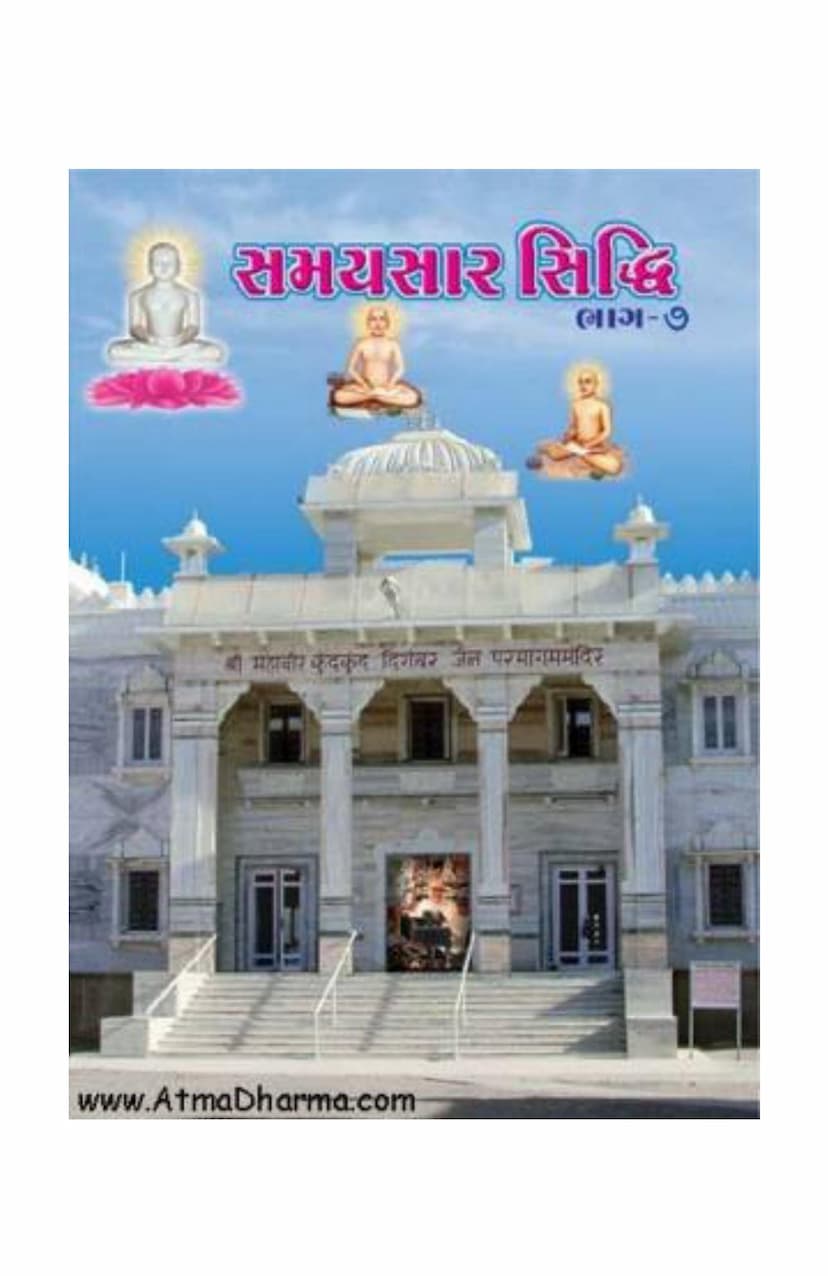Samaysara Siddhi 07
Added to library: September 2, 2025

Summary
The provided text is the 7th part of "Samaysara Siddhi," a commentary by Kanjiswami on Acharya Kundakunda's "Samaysara." This specific volume covers verses 193 to 236 of the "Nirjara Adhikar" section of Samaysara. The text comprises 45 discourses delivered by Kanjiswami on these verses.
Here's a comprehensive summary of the key themes and points discussed in the provided text:
Core Theme: The Path to Liberation (Moksha) through Self-Realization
The central message of this volume, following the lineage of Jain spiritual teachings, is the profound understanding and realization of the true nature of the soul (Ātmā). Kanjiswami, through his commentary on Samaysara, aims to guide individuals towards this realization, emphasizing that liberation is achieved not through external rituals or good deeds but through an internal transformation of consciousness.
Key Concepts and Teachings:
-
The True Nature of the Soul:
- The soul is described as the "Lord of Consciousness," a mountain of bliss, a deep ocean of joy, and a sea of happiness.
- It is characterized as the knower (jñāyaka), the judge of virtues, a stream of righteousness, an eternal flow, a stream of knowledge, the lord of the three worlds, a tree of consciousness bearing nectar-like fruits, and the true essence.
- The soul is also likened to a wish-fulfilling jewel (Chintamani), a wish-fulfilling tree (Kalpavriksha), and a wish-fulfilling cow (Kamadhenu), signifying its inherent power and self-sufficiency.
- The soul is described as infinite in qualities and powers, a treasure trove of consciousness.
-
The Essence of Samaysara:
- Samaysara is considered the most supreme scripture, the "Agam of Agams," and the crown jewel of principles.
- It is highlighted as the path to becoming disembodied (ashariri) and the key to awakening the dormant soul.
- The scripture contains the complete treasure of the pure soul and the secret to spiritual awakening.
-
The Role of Kanjiswami:
- Kanjiswami is revered as an "Adhyatma Yugpurush" (Man of the Era of Spirituality), an embodiment of spirituality, a creator of spiritual realms, a saint of self-knowledge, and a compassionate soul who liberates beings from the cycle of birth and death.
- He is credited with making the profound and subtle meanings of ancient Acharyas' teachings accessible to the common person through his divine and nectar-like words.
- His discourses are described as a divine sound (divya dhwani) emanating directly from the Lord of the Three Worlds.
-
Distinguishing True Spirituality from Rituals:
- The text strongly differentiates the Jain path to liberation from mere external rituals, good deeds, fasting, or temple building. These are considered external and ultimately unable to break the cycle of karma.
- The true path is presented as an internal realization of the soul's pure, unchanging nature, distinct from all karmic conditions and external attachments.
- The critique of ritualistic practices and the emphasis on internal transformation is a recurring theme, highlighting that true spirituality lies in the realization of the soul, not in performing outward actions.
-
The Importance of Self-Knowledge and Discrimination:
- Kanjiswami emphasizes the need to discriminate between the soul (Ātmā) and non-soul (Anātmā) – karma, body, senses, thoughts, and emotions.
- The true self is the pure, eternal, conscious, blissful soul, which is beyond all forms of bondage and suffering.
- The text stresses the importance of constant introspection and self-awareness to realize this true nature.
-
The Nature of Bondage and Liberation:
- Bondage is described as arising from attachment, identification with the non-soul, and the resulting desires and aversion.
- Liberation (Moksha) is achieved by realizing the soul's inherent purity and freedom from all external influences and internal impurities, particularly through unwavering self-knowledge and detachment.
-
The Concept of Nirjara (Shedding of Karma):
- While the discourses focus on the realization of the soul, the underlying context of "Nirjara Adhikar" implies the process of shedding karma. This shedding is a natural consequence of self-realization and detachment from the non-soul.
- The text distinguishes between different types of "Nirjara" (shedding of karma), emphasizing that true liberation comes from internal purification, not external austerities.
-
The Teachings of Kundakunda and Amritachandra:
- The text pays homage to Acharya Kundakunda, the author of Samaysara, and Acharya Amritachandra, the commentator whose "Atmākhyāti" commentary is highly praised for its depth and insight.
-
The Role of Faith and Understanding:
- The discourses aim to instill true faith and understanding of the soul's nature. It's not just about hearing the words but internalizing them and living by them.
- The repetition of listening to these teachings is crucial for spiritual progress.
Structure and Content of the Volume:
- The book contains 45 discourses (pravachans), numbered from 268 to 312, covering verses 193 to 236 of the "Nirjara Adhikara."
- It includes an introduction (prastavana) and prayers/salutations to Jain Tirthankaras and Acharyas.
- The discourses are based on Kanjiswami's elucidation of the Samaysara text, offering deep spiritual insights.
- The publication is attributed to Shri Simandhar Kundkund Kahan Aadhyatmik Trust, Rajkot.
- The text includes an index (anukramanika) listing the discourse numbers, dates, and the verses/shlokas covered in each.
In essence, this volume of "Samaysara Siddhi" by Kanjiswami serves as a profound guide to understanding the soul's true nature and the path to liberation, emphasizing introspection, self-knowledge, and detachment from the non-soul as the means to achieve ultimate freedom.